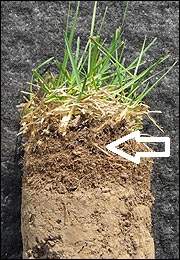Index was out of range. Must be non-negative and less than the size of the collection.
Parameter name: index
What is lawn thatch and how do I check for it?
 Thatch is a layer of living and dead grass crowns, roots, lower shoots and other organic debris at the soil surface. It can weaken and even destroy a lawn if not controlled. Thatch is not caused by leaving short grass clippings on the lawn. Thatch is caused by excessive growth and conditions unfavorable to microorganisms which decompose dead grass. Rapid and excessive growth causes thatch, because plant material is being produced faster than it can be decomposed. Thatch can build up over a few years to form a mat often more than an inch deep. Grasses like bluegrass and zoysia grass that spread by rhizomes, stolons or both develop thatch faster than clump grasses like fescue. Thatch buildup is also related to low populations of earthworms and night crawlers in the lawn. Earthworms naturally reduce thatch as they collect it from the surface and mix it deeper into the soil.
Thatch is a layer of living and dead grass crowns, roots, lower shoots and other organic debris at the soil surface. It can weaken and even destroy a lawn if not controlled. Thatch is not caused by leaving short grass clippings on the lawn. Thatch is caused by excessive growth and conditions unfavorable to microorganisms which decompose dead grass. Rapid and excessive growth causes thatch, because plant material is being produced faster than it can be decomposed. Thatch can build up over a few years to form a mat often more than an inch deep. Grasses like bluegrass and zoysia grass that spread by rhizomes, stolons or both develop thatch faster than clump grasses like fescue. Thatch buildup is also related to low populations of earthworms and night crawlers in the lawn. Earthworms naturally reduce thatch as they collect it from the surface and mix it deeper into the soil.
A thatch layer becomes a waterproof blanket on the soil surface. Roots and rhizomes of turf grass grow in the thatch layer rather than in the soil where they belong. Grass roots become shallow and your lawn becomes more prone to drought stress. Thatch makes it difficult to get water, nutrients, and oxygen to the soil and to the roots of the grass.
You do not have to dethatch your lawn every year. Always check how deep your lawn's thatch layer is before you dethatch. Dethatch the lawn when more than 1/2 inch of thatch develops.
Checking for thatch is easy. All you need is a sturdy knife and a few minutes of time. Here is how to do it. First, cut a pie shaped wedge out of the lawn making sure to get down into the soil. Second, pull the wedge and examine the area just above the soil surface. Look for a layer of brown, tightly compressed, peat moss-like material. That is what thatch looks like. If it is more than one half inch thick in a particular location, it could be causing problems. Steps should be taken to reduce the thatch or remove it completely. Third, replace the wedge into the lawn and press into the ground with your foot. Repeat these three steps in several places in the lawn. Just because thatch is present or absent in one location does not mean the same is true in another place.
Thatch can be controlled in a number of ways. Top dressing the lawn with one fourth inch of top soil speeds natural thatch decomposition. Core-aerating machines, which remove plugs from the lawn and deposit them on the surface, accomplish the same end. You can also remove thatch with vertical cutting mowers or power rakes which are often called dethatching machines. Rake and compost the material you remove with these machines.
Lawns should be dethatched when they are actively growing. Mid-summer is the preferred time for warm-season grasses such as zoysia grass and Bermuda grass. Early fall is most desirable for cool season grasses such as fescues, Kentucky bluegrass, and ryegrasses. These periods characterize the times of active lawn growth which are best for recuperation after dethatching.